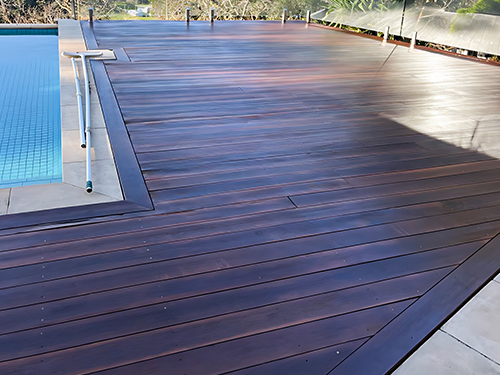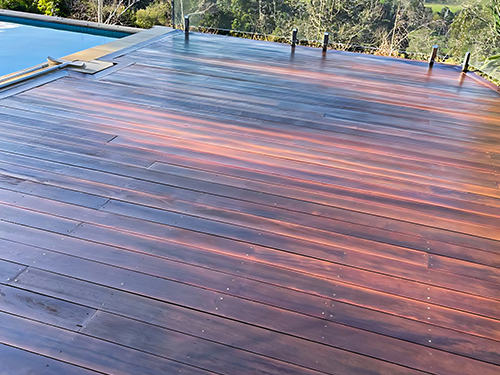So, you built this beautiful composite deck a few years back, thinking it would stay pristine forever. But over time, constant exposure to sun and weather has faded your decking and dulled that rich, wood-like colour you loved. Don’t despair – you can bring your deck back to life and make it look as good as new with some decking restoration Melbourne work.
In this article, we’ll show you how to restore faded composite decking in just a few easy steps. You don’t need any fancy tools or skills, just some elbow grease and the right cleaning and re-colouring products.
Before you know it, your deck will look fresh and vibrant again, ready to host many more barbecues and parties. Let’s get started!
What Causes Composite Decking to Fade?
The sun is the number one culprit for faded composite decking. Exposure to UV radiation breaks down the plastic materials and fades the colourants used to dye the wood fibres and plastics. Over time, this photodegradation causes the decking to turn grey and lose its original hue.
Moisture and humidity also contribute to fading. When water penetrates the decking, it speeds up the deterioration of the dyes and materials. The damper and more humid the climate, the faster composite decking will fade.
To slow down fading, limit sun exposure, when possible, seal and re-stain the decking regularly, and clean the deck periodically to prevent the buildup of pollutants. While some fading is inevitable, taking these steps will help your composite decking retain its colour and last longer.
Understanding the Material
Composite decking is made from a blend of wood fibres and plastic resins. Over time, the UV radiation from the sun fades the wood fibres, dulling the colour. The question is, can you restore composite decking? The good news is you can restore that like-new look with a little elbow grease.
Cleaning and Sanding
Give your deck a good scrub with a deck cleaner or brightener to remove any built-up dirt and grime. For tough stains, use a pressure washer. Lightly sand the surface with fine-grit sandpaper (around 220 grit) to rough up the top layer. This helps the new stain adhere better.
Choosing a Stain
Water-based acrylic stains are a great choice for composite decks. They contain UV blockers to prevent future fading and provide good coverage in one coat. For the best colour match, choose a stain specifically designed for composite decks. Oil-based stains can darken the wood fibres unevenly.
Applying the Stain
Use a pump sprayer, roller, or brush to apply 2 coats of stain, waiting at least 2 hours between coats. Make sure to wipe away any excess stain that hasn’t soaked in after 30 minutes. Once the final coat is dry, your deck will look as good as new. An annual maintenance coat will keep your deck protected and beautiful for years to come.
Assessment: Determining the Extent of Fading
Assessing how much your composite decking has faded will determine the steps needed to restore it.
Take a close look at your deck to see the overall level of fading. Check if it’s only surface fading, meaning the top layer, or if the fading goes deeper into the material. See if certain areas like edges, seams and screws are more faded than the rest of the deck. Notice if the fading is uneven, with splotches of colour remaining in some spots.
Also, inspect for any damage beyond normal weathering, like deep scratches, gouges or water damage, before starting restoration. Once you’ve determined the extent of fading and condition of your decking, you can choose the appropriate restoration method, whether it’s deep cleaning, re-staining, or, in severe cases, partial board replacement.
Regular maintenance like sweeping, mopping and rinsing off your deck will help slow down fading over time. Re-staining and re-sealing your deck every 2-3 years is ideal. For heavier decking restoration Melbourne, more intensive steps may be needed to return your composite decking to like-new condition.
Tools and Materials You’ll Need
To restore your faded composite decking, you’ll need a few supplies.
Cleaning solution
You’ll want a composite deck cleaner or a mixture of detergent and oxygen bleach. Avoid using harsh chemicals, abrasive cleaners, or scrubbers, which can damage the decking.
Applicator pads
Use a deck mop, sponge, or non-abrasive scrub pads to apply the cleaning solution. Soft-bristled brushes also work well for stubborn stains in grooves and edges.
Rinse tool
Have a hose, power washer or deck brush ready to rinse and remove dirt and grime from your decking after cleaning. Make sure to rinse thoroughly to avoid residue.
Protective gear
Wear old clothes, gloves, and eye protection. The cleaning solutions can irritate your skin, and the power washer can splash back.
Resealing product (optional)
For severely faded composite decks, you may need to reseal the surface after cleaning and rinsing to restore colour and protection. Use a composite deck sealer or re-stainer and follow the directions on the product.
With the proper tools and materials on hand, you’ll have your composite deck looking refreshed and rejuvenated in no time. Be prepared for the work ahead by gathering everything you need before getting started. Your deck will thank you for the little bit of extra effort.

Step-by-Step Guide: how do you restore faded composite decking
Once your composite decking has faded from sun exposure and weathering, it’s time for a refresh. Here’s a simple step-by-step guide on how to restore decking to like-new condition:
Clean the Deck
Use a pressure washer to remove built-up dirt and grime. Be sure to sweep away any remaining debris. Scrub any stubborn stains before they set in. Let the deck dry completely.
Lightly Sand
Lightly sand the surface to rough up the top layer and provide a “tooth” for the new sealant to adhere to. Wipe away dust with a tack cloth.
Apply Sealant
Apply 2-3 coats of composite deck sealer or stain, waiting 2-3 hours between coats. Use a paintbrush to coat railings and hard-to-reach areas, then use a roller for large, open areas. Select a sealant formulated specifically for composite decks in a shade that closely matches your faded decking.
Protect the Sealant
Once the final coat is dry, protect your work by avoiding foot traffic on the deck for at least 24-48 hours. The longer you can keep furniture and planters off the deck, the better. Place protective pads under furniture legs to avoid scratches.
In a few easy steps, you’ve refreshed and rejuvenated your composite decking. Regular cleaning and re-sealing every 2-3 years will help keep your deck looking its best for years to come. Annual inspections for any signs of water damage or structural issues are also a good idea. With some TLC, your composite deck can provide decades of enjoyment!
Choosing the Right composite deck refinishing and restoration Products
When it’s time to refinish faded composite decking, you’ll want to choose decking restoration Melbourne products designed specifically for composite and PVC deck materials.
Regular paints and stains won’t properly adhere to composite decking and will quickly start to peel away. Instead, look for specialised composite deck refinishers, restores, and rejuvenators.
These penetrating products are formulated to bond with the surface of composite decking and restore colour without leaving behind a film finish.
Popular brands for refinishing composite decks include:
- Restore-A-Deck Composite Deck Restorer
- Olympic Rescue It! – Composite & PVC Deck Resurfacer
- Rust-Oleum Restore Composite Deck Resurfacer
For the best results, thoroughly clean your deck to remove built-up dirt and grime before applying the refinishing product. Follow the directions on the product to determine if one or two coats are needed. Composite deck refinishers typically dry to the touch within a couple of hours but may take 24-48 hours to fully cure.
Professional Tips for Restoring Colour and Shine
As a homeowner, restoring faded composite decking is something you’ll likely have to do at some point. Here are some tips from the pros to bring back the colour and shine:
Scrub away built-up grime. Use a stiff brush and deck cleaner or brightener to scrub off dirt and debris from between boards and railings. Rinse thoroughly with a hose to remove all residue.
Lightly sand rough spots. For areas where stains or damage have penetrated the outer sealant or for splinters and cracks, use fine-grit sandpaper to sand and smooth. Wipe away dust before sealing.
Apply a quality sealant. Choose a sealant specifically for composite decks that contains UV blockers and waterproofing agents, such as acrylic or polyurethane. Follow directions to roll or spray it onto your deck, waiting the recommended time between coats.
Re-stain for colour. For a vibrant colour boost, apply a composite deck stain in your desired hue. Look for a stain containing pigments and sealants to restore colour and provide protection. Apply as directed, waiting the recommended time before use.
Protect your investment. Place protective pads under furniture, use a leaf blower to keep your deck clear of debris, and re-seal your deck every 2-3 years or sooner if water no longer beads up. These measures will help prevent damage and keep your deck looking its best for years to come.
Common Mistakes to Avoid During Restoration
Avoiding common mistakes during the restoration process will help ensure the best results for your composite decking.
Using the Wrong Cleaners
Harsh chemicals can damage composite materials and fade colours. Only use cleaners specifically for composite decks. Vinegar, dish soap, and water make a simple and effective composite-safe cleaner.
Abrasive tools like steel wool, abrasive sponges, and strong detergents should also be avoided, as they can scratch the surface. For stuck-on debris, use a plastic scraper or scrubber. Rinse the deck thoroughly when cleaning is done to remove any remaining residue.
Not Sealing Properly
Applying a quality composite deck sealer helps protect against UV damage, fading, and staining. Not sealing or improper sealing allows damage to occur. Clean and seal your composite deck each year as directed.
Staining Mistakes
When staining a composite deck, work in small sections to avoid lap marks. Use an angled brush for corners and edges. Apply at least two coats, waiting 24 hours between applications. Don’t over-stain—wipe away any excess stain within 5 to 10 minutes.
By avoiding these common mistakes, you’ll restore your faded composite decking to like-new condition and keep it looking great for years to come.
Professional Insights for composite decking restoration
Many decking restoration Melbourne companies and contractors have useful insights into restoring faded composite decking. Here are a few professional tips:
Clean and Brighten
According to our deck experts, the first step is to thoroughly clean your composite deck to remove built-up dirt and stains. Use a composite deck cleaner or a mixture of oxygen bleach and water. Scrub the deck with a stiff brush. Rinse well with a pressure washer on a low setting. This will instantly brighten your deck’s appearance.
Restore Colour
If cleaning alone doesn’t restore your deck’s colour, you can apply a composite deck stain or sealant. Look for a product specifically meant for restoring composite decks. Wipe it on with a roller or brush, let it soak in as directed, then wipe off any excess. This will rejuvenate your deck’s colour and provide protection from future fading and stains.
Avoid Resurfacing
Professionals warn against sanding, resurfacing or painting composite decks, as this can damage the material and void warranties. Stick with cleaning, brightening and staining products designed specifically for composite decking. With regular maintenance, a faded composite deck can often be fully revived without resurfacing.
Re-stain When Needed
For severe fading, re-staining your composite deck every 2-3 years may be required. Look for a stain with UV protection to help prevent future fading. By following our professional tips, you can restore a faded composite deck to like-new condition and keep it looking its best for years to come.
Deck Restoration Cost Breakdown
Deck restoration can vary in cost depending on the condition of your deck and how much work needs to be done. Here’s a rough breakdown of what you can expect to pay:
1. Deck Size and Complexity: The size of your deck is a significant factor in cost. Larger decks naturally demand more materials and labour. Additionally, the complexity of the deck’s design, like intricate railings or multiple levels, can impact costs. Think of it like a puzzle – more pieces, more time.
2. Current Deck Condition: The state of your deck plays a pivotal role. If it’s just suffering from surface fading, the costs might be lower. However, if there’s extensive damage, like warped boards or structural issues, expect a higher price tag. It’s like comparing a fresh coat of paint to a full restoration; the latter requires more effort.
3. Required Repairs: Repair needs significantly contribute to costs. Replacing damaged boards, fixing structural issues, or addressing deep-seated problems adds to the overall expense. It’s akin to addressing a leaky roof alongside a fresh paint job – necessary, but it impacts the budget.
4. Professional Expertise: Hiring professionals comes at a cost, but their expertise ensures a job well done. Experienced professionals may charge higher rates, but the quality and efficiency they bring can save you money in the long run. It’s like paying for peace of mind – an investment in the longevity of your deck.
While composite decking is low-maintenance, it can fade over time with exposure to the elements. To restore faded composite decking and bring it back to like-new condition, here are a few tips:
Clean the deck thoroughly. Scrub away dirt and debris with a composite deck cleaner or a mixture of detergent and oxygen bleach. Rinse well with a hose.
Lightly sand rough or splintered areas. Use fine-grit sandpaper, scrubbing in the direction of the grain. Wipe away the dust before staining.
Apply a quality composite deck stain or sealer. Look for a product specifically designed for composite materials that contain UV blockers to prevent future fading. Roll it on with a paint roller or brush, waiting for each coat to dry as directed.
Consider refinishing the deck borders and railings. For the best results, stain or paint the vertical parts of your deck, including railings, posts, and the outer rim. This helps create an attractive, cohesive look.
Re-treat every 2-3 years. To keep your deck looking fresh and clean, re-stain it every couple of years. Frequent maintenance will extend the life of your composite deck and enhance its appearance.
Your efforts will be well worth it when you can once again enjoy your beautiful outdoor living space.
So, there you have it – with a little time, patience, and elbow grease, you can get that faded composite deck looking like new again. Once you’ve cleaned, sanded, and stained or painted your deck, it’ll be the envy of the neighbourhood again.
And when it comes to decking transformations, trust the expertise of Timber Floor Sanding Melbourne. Your weathered deck can become a vibrant outdoor haven with the right care.
So, embrace the process, enjoy the results, and let our decking restoration Melbourne experts bring out the best in your composite deck!


